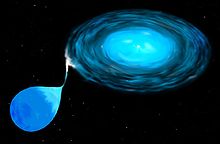

| |
| Observation data Epoch J2016.0 Equinox J2000.0 | |
|---|---|
| Constellation | Hercules |
| Right ascension | 18h13m 11.13s[1] |
| Declination | 42° 51′ 50.4″[1] |
| Apparent magnitude (V) | 18.72[2] |
| Astrometry | |
| Radial velocity (Rv) | 461.3[1] km/s |
| Proper motion (μ) | RA: −12.317[3] mas/yr Dec.: −2.656[3] mas/yr |
| Parallax (π) | 1.1975 ± 0.1551 mas[3] |
| Distance | approx. 2,700 ly (approx. 800 pc) |
| Orbit[1] | |
| Period (P) | 51.16 min |
| Semi-major axis (a) | 0.4 R☉ |
| Eccentricity (e) | 0 (fixed) |
| Inclination (i) | 78.80° |
| Semi-amplitude (K2) (secondary) | 461.3 km/s |
| Details[1] | |
| White Dwarf | |
| Mass | 0.562±0.015 M☉ |
| Radius | 0.01374±0.00023 R☉ |
| Surface gravity (log g) | 7.9 cgs |
| Temperature | 12600±500 K |
| Donor | |
| Mass | 0.1185±0.0067 M☉ |
| Radius | 0.1017±0.0019 R☉ |
| Surface gravity (log g) | 5.43 cgs |
| Temperature | 6000±80 K |
| Rotational velocity (v sin i) | 145 km/s |
| Other designations | |
| Database references | |
| SIMBAD | data |
ZTF J1813+4251 is a binary star system including a star and white dwarf, co-orbiting every 51 minutes, about 3,000 light years away in the constellation of Hercules. It is considered a cataclysmic variable with the white dwarf pulling outer layers of hydrogen from the star onto itself. It has the shortest orbital period of all hydrogen-rich cataclysmic variable stars known. It is predicted that the orbital period will reach a minimum of 18 minutes within 75 million years as the system evolves.[1]

It was identified in 2022 by Kevin Burdge of MIT using a computer algorithm that searched over 1,000 images from the Zwicky Transient Facility, identifying stars that had brightness variability periods around one hour.
|
| |||||||||||||
|---|---|---|---|---|---|---|---|---|---|---|---|---|---|
| |||||||||||||
| Stars |
| ||||||||||||
| |||||||||||||
| |||||||||||||
| |||||||||||||
| Galaxies |
| ||||||||||||
| |||||||||||||
| |||||||||||||
|
2022 in space
| ||
|---|---|---|
2023 » | ||
| Space probe launches |
| |
| Impact events |
| |
| Selected NEOs |
| |
| Discoveries |
| |
| Comets |
| |
| Space exploration |
| |
| ||
This variable star–related article is a stub. You can help Wikipedia by expanding it. |
This binary or multiple star system–related article is a stub. You can help Wikipedia by expanding it. |